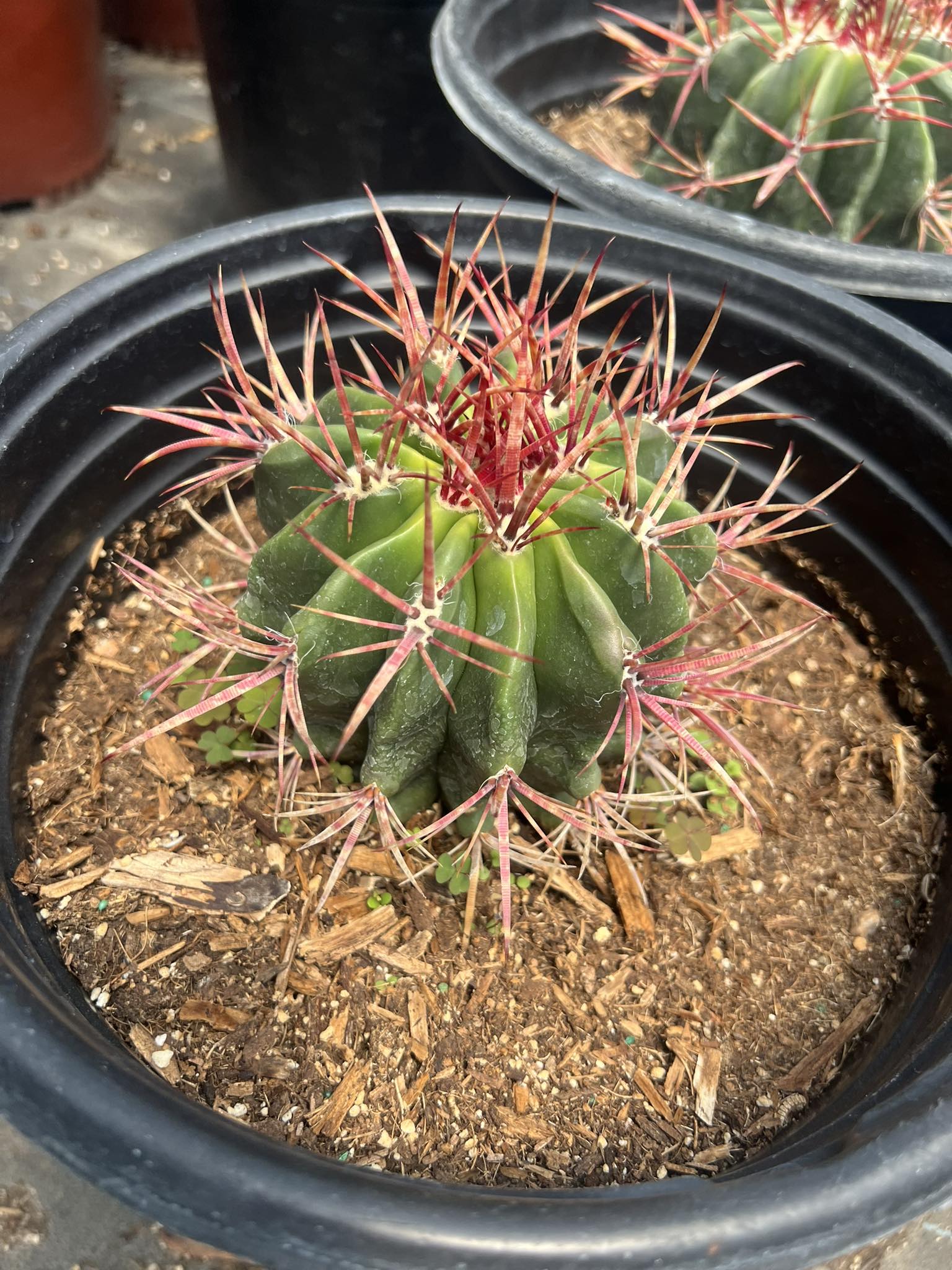Fire Barrel Cactus (Ferocactus pilosus) “the Desert’s Fiery Sentinel
The Fire Barrel Cactus, scientifically known as Ferocactus pilosus, is a stunning and hardy cactus endemic to northern and central Mexico, notably the Chihuahuan Desert. The “”Fire Barrel”” moniker comes from its brilliant, fiery red to orange spines, which stand out against the ribbed body’s rich green.
Due to its striking appearance, resistance to harsh conditions, and low maintenance requirements, this species is popular among cactus collectors, landscape architects, and aficionados.
🌿 Botanical Overview
Ferocactus pilosus is the scientific term.
Popular Names: Fire Barrel Cactus, Mexican Fire Barrel, Mexican Lime Cactus
Family: Cactaceae
Origin: Central and Northern Mexico
Growth Pattern: Columnar to barrel-shaped, either alone or in clumps
Size:
Typical height: 90–150 cm (3–5 feet), though it may get higher in the wild
Diameter: 18–24 inches, or 45–60 cm
13 to 20 vertical ribs stand out.
Spines: thick, curved, and bright red, orange, or rust-colored
Hardiness Zones from the USDA: 9–11
Fruits and Flowers
Late spring to summer is the blooming season.
Flowers:
Little, funnel-shaped, and frequently red, orange, or yellow
Bloom at the top of fully grown plants
Fruits:
Frequently inedible, dry, and little
covered in fluffy hair
It takes the cactus many years to flower, particularly when grown.
Temperature and Sunlight Requirements
Sunshine:
flourishes when exposed to direct sunlight
Needs 6–8 hours of direct sunshine every day to promote healthy development and the best color.
Indoors: Put it in a sunny window facing south.
Temperature:
Between 21 and 35 degrees Celsius (70 and 95 degrees Fahrenheit) is the ideal temperature range for plant growth.
If the soil is dry, it can withstand brief frosts up to –6°C (20°F).
Enjoys warm, dry environments with little humidity
The spines’ vibrant, blazing color is maintained by direct sunshine.
Watering Schedule
Growing Season (Spring to Early Fall):
When the top 5 to 7 cm (2 to 3 inches) of soil is dry, water thoroughly.
Frequency: Every 2–3 weeks, depending on the environment and exposure
Between waterings, let the soil dry out completely.
Winter Dormancy
Only use water sparingly, around once every 4–6 weeks.
Water only when the soil is completely dry in cold weather
The biggest risk is overwatering, which can result in root rot.
Soil Requirements
Kind:
Needs a cactus or succulent mixture that drains well.
Recommended combination:
50% cactus dirt
25% coarse sand
25% perlite or pumice
pH: Between 6.5 and 7.5, or between neutral and somewhat alkaline
To mimic its natural desert environment, excellent drainage is necessary.
Fertilizing Calendar
Season of Active Growth (Spring to Summer):
Use a diluted cactus fertilizer with low nitrogen content, such as 5-10-10, to fertilize every 4–6 weeks.
Use slow-release granules or liquid feed.
Autumn to Winter – Dormant Season:
Refrain from fertilization
Overfeeding can lead to unnatural and stunted development patterns.
Keeping Things in Order with Pruning and Maintenance
Trimming:
Typically only necessary when removing diseased or broken tissue
Cleanup:
To eliminate dust and debris, use a gentle brush.
Controlling Pests:
Keep an eye out for scale bugs, spider mites, and mealybugs.
Use neem oil or insecticidal soap as treatment.
🌿 Propagation
Via Seeds:
Plant seeds in a seed mix that drains well.
With consistent moisture, keep the temperature between 25 and 30 degrees Celsius (or 77 and 86 degrees Fahrenheit).
It may take weeks for seeds to germinate.
Via Offsets:
The base of some older plants may give rise to pups.
Take off with care and let the incision callus for a few days before planting.
For committed collectors, growing from seed is a slow but worthwhile endeavor.
Pests and Diseases
Typical Pests: Spider mites, mealybugs, scale insects
Diseases: Fungal infections if humidity is too high, root rot caused by overwatering
To prevent issues, make sure there is sufficient sunshine, water, and airflow.
Use for decorating and landscaping
Best Use:
Rock and desert gardens
Xeriscaping
The focal points of landscape architecture
Big patio pots or containers
Goes well with:
Agave kind
Barrel Cactus, Blue
Varieties of aloe
Golden barrels for contrasting colors
Due to its strong shape and striking red spines, it is a focal point in xeriscaping and drought-tolerant gardens.
✅ Conclusion
With its fiery spines, the Fire Barrel Cactus (Ferocactus pilosus) is a low-maintenance, eye-catching cactus that provides both beauty and resilience. This cactus not only grows in arid desert environments but also brings color, texture, and drama to gardens and collections.”
Fire Barrel Cactus
₨1,200.00
“The striking and colorful Fire Barrel Cactus (*Ferocactus pilosus*), also known as the Mexican Fire Barrel Cactus or Ferocactus stainesii, is a native of central and northern Mexico. Its ribbed, cylindrical to barrel-shaped body is covered in thick, blazing red spines that produce a stunning visual impact.
This cactus grows best in well-drained, sandy, or rocky soil and in direct sunlight. It doesn’t need much watering and is drought-resistant, particularly in the winter. Mature plants bear red to yellow blooms at the top of the plant throughout the summer, which enhances its aesthetic value even more.
Renowned for its striking spines, architectural shape, and easy upkeep, the Fire Barrel Cactus is perfect for desert environments, rock gardens, and cactus collections. In gardens with arid and succulent themes, its strong coloring offers a striking contrast.”
Related products
-
Cactus
Agave Victoria
Rated 0 out of 5₨3,000.00Original price was: ₨3,000.00.₨2,499.00Current price is: ₨2,499.00. -
Cactus
Moon Cactus (Red), Grafted Cactus
Rated 0 out of 5₨800.00Original price was: ₨800.00.₨699.00Current price is: ₨699.00.





Reviews
There are no reviews yet.